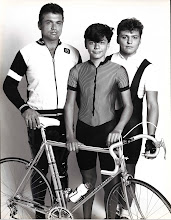Friday, March 18, 2011
Sunday, November 1, 2009
Sunday, October 11, 2009
Monday, October 5, 2009
RED OKTOBER Bicycle Swap Meet Cycles de ORO's Red Oktober Bicycle SWAP MEET! Friday night, October 23rd, next doorto Cycles de ORO bike shop inside in the old book store space. BenefitsNat MS Society. A true person-to-person swap meet, buy sell, trade bikegoo...dies (only) + a display of tasty vintage bikes. Info here:http://tinyurl.com/ya6qpk8
Saturday, October 3, 2009
Thursday, October 1, 2009

PETER MOONEY:
Peter Mooney was born in London, England in 1955; moving to the greater Boston
area in 1964. He secured his first bike shop job in 1968, working in Central Square,
Cambridge selling cheap Italian 10 speeds and English 3 speeds. He's been in bike
shops ever since.
Peter's love of bicycles led him to competitive cycling. He got his first ABLA License
(now USCF) in 1969 and joined the North East Bicycle Club. Rising up through the
ranks, Peter held a Cat 1 license from 1974 to 1978 qualifying for and competing
in National Championship events for Road and/or 25 mile Time Trial in 1974, 1977 & 1982. While living in England from late 1974 to early 1976, Peter raced Road, Time Trials and Track events, typically competing in 3-5 events a week, in season. He enjoyed success with Time Trials, in particular.
During the 1970's & 80's, Peter also completed many bicycle touring trips in Spain, France, Holland, Belgium, England, New England, New York and Maritime Canada. He also competed in Cross-Country ski races and rowing events in the 1970-80's. He has been and remains a staunch bicycle commuter, having ridden his bike to work for 98% of his entire working life.
Peter learned his trade in England during the mid 1970's working for a noted south London frame builder. This "one man show' operated a small but full service bicycle shop. Be it a tricycle for your 3 year old or a custom pursuit frame for the world championships, this tiny store front offered it all.
This European model of an "in house" frame builder being part and parcel of a high quality bike shop inspired Peter (and like minded partners) to open the first wheel works store in 1977. Peter has enjoyed the position of frame builder in residence ever since.
29 years later, Peter is still building bicycle frames - catering to a market that appreciates a hand built, lugged or fillet brazed frame. His philosophy of frame building is traditional, but hardly out of date. He feels the name on the frame should be that of the craftsman who designed and constructed it. Peter is a great believer in the old adage "if you want it done right-do it yourself." So he does. From the fitting session to the finish filing, only the painting is entrusted to other hands. Otherwise the name on the frame tells the whole story of its designer and creator.
Peter Mooney frames have always been constructed from the highest quality, bicycle specific, steel tubing stock. Suppliers include: Dedacciai, Columbus and Reynolds. Tubing is bonded with bronze or silver - utilizing hand finished lugs or filet brazed joints.
Wednesday, September 30, 2009
This One is Done in WhiteThread White Leather Ciclo Di Cuoio on 3ttt Handlebars & Stem

This One is Done in WhiteThread White Leather Ciclo Di Cuoio on 3ttt Handlebars & Stem
Originally uploaded by Ciclo Di Cuoio /Cycle Leather+Vintage Pro Bicycles
Campagnolo Super Record on a Carnevale Bicycle sr #50-02261

Campagnolo Super Record on a Carnevale Bicycle sr #50-02261
Originally uploaded by Ciclo Di Cuoio /Cycle Leather+Vintage Pro Bicycles
Bob Jackson (Hetchins) Headtube
Bob Jackson (Hetchins) Headtube
The little Reynolds 531 sticker looks funny to my eyes...(I'm partial to the classic triangular one so common in the 60's-70's). But any sticker on the fork would clash with that lug!
The little Reynolds 531 sticker looks funny to my eyes...(I'm partial to the classic triangular one so common in the 60's-70's). But any sticker on the fork would clash with that lug!
| Fausto Coppi's 1952 race bike |
PLEASE REMEMBER !
On the 2nd of January 2010 there will be the
50th Anniversary of Fausto Coppis death. I
hope that sportsmen and sportswomen all over
the world will honour the
memory of the greatest cyclist of history and,
at the same time, of
one of t...he most important champions of the
whole sport.
Fausto sempre nei nostri cuori.
Allez Fosto Copi.
Angelo Fausto Coppi, (born in Castellania, Italy, 15 September 1919, died in Tortona, Italy, 2 January 1960), was the dominant international cyclist of the years each side of the second world war. His successes earned him the title Il Campionissimo, or champion of champions. He was an all-around racing cyclist, he was the best in both climbing and time trialing, and was also a great sprinter. He won five times the Giro d'Italia (1940, 1947, 1949, 1952, 1953), twice the Tour de France (1949 and 1952), the World Championship in 1953, the Giro di Lombardia in 1946, 1947, 1948, 1949 and 1954, the Milan-Sanremo in 1946, 1948 and 1949, the Paris-Roubaix and the La Flèche Wallonne in 1950 and set the hour record (45.798 km) in 1942.
Subscribe to:
Comments (Atom)








































